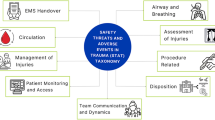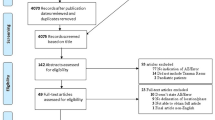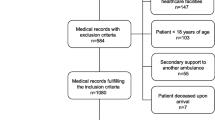Abstract
Purpose
Adverse events (AEs) during trauma resuscitation are common and heterogeneity in reporting limits comparisons between hospitals and systems. A recent modified Delphi study established a taxonomy of AEs that occur during trauma resuscitation. This tool was further refined to yield the Safety Threats and Adverse events in Trauma (STAT) taxonomy. The objective of this study was to evaluate the inter-rater reliability of the STAT taxonomy using in-situ simulation resuscitations.
Methods
Two reviewers utilized the STAT taxonomy to score 12 in-situ simulated trauma resuscitations. AEs were reported for each simulation and timestamped in the case of multiple occurrences of a single AE. Inter-rater reliability was assessed using Gwet’s AC1.
Results
The agreement on all AEs between reviewers was 90.1% (973/1080). The Gwet’s AC1 across AE categories were: EMS handover (median 0.72, IQR [0.54, 0.82]), airway and breathing (median 0.91, IQR [0.60, 1.0]), circulation (median 0.91, IQR [0.72, 1.0]), assessment of injuries (median 0.80, IQR [0.24, 0.91]), management of injuries (median 1.00, IQR [1.00, 1.00]), procedure related (median 1.00, IQR [81, 1.00]), patient monitoring and IV access (median 1.00, IQR [1.00, 1.00]), disposition (median 1.00, IQR [1.00, 1.00]), team communication and dynamics (median 0.80, IQR [0.62, 1.00]).
Conclusions
The STAT taxonomy yielded 90.1% agreement and demonstrated excellent inter-rater reliability between reviewers in the in-situ simulation scenario. The STAT taxonomy may serve as a standardized evaluation tool of latent safety threats and adverse events in the trauma bay. Future work should focus on applying this tool to live trauma patients.
Similar content being viewed by others
Data availability
A de-identified dataset associated with the paper is available upon reasonable request.
References
Nolan B, Petrosoniak A, Hicks CM, Cripps MW, Dumas RP. Defining adverse events during trauma resuscitation: a modified RAND Delphi study. Trauma Surg Acute Care Open. 2021;6(1): e000805.
Nikouline A, Quirion A, Jung JJ, Nolan B. Errors in adult trauma resuscitation: a systematic review. Can J Emerg Med Care. 2021;23(4):537–46. https://doi.org/10.1007/s43678-021-00118-7
Fitzgerald M, Gocentas R, Dziukas L, Cameron P, Mackenzie C, Farrow N. Using video audit to improve trauma resuscitation–time for a new approach. Can J Surg J Can De Chir. 2006;49(3):208–11.
Chang A, Schyve PM, Croteau RJ, O’Leary DS, Loeb JM. The JCAHO patient safety event taxonomy: a standardized terminology and classification schema for near misses and adverse events. Int J Qual Health C. 2005;17(2):95–105.
Fan M, Petrosoniak A, Pinkney S, Hicks C, White K, Almeida APSS, et al. Study protocol for a framework analysis using video review to identify latent safety threats: trauma resuscitation using in situ simulation team training (TRUST). BMJ Open. 2016;6(11):e013683.
Petrosoniak A, Fan M, Hicks CM, White K, McGowan M, Campbell D, et al. Trauma Resuscitation Using in situ Simulation Team Training (TRUST) study: latent safety threat evaluation using framework analysis and video review. Bmj Qual Saf. 2021;30(9):739–46. https://doi.org/10.1136/bmjqs-2020-011363
Dumas RP, Vella MA, Hatchimonji JS, Ma L, Maher Z, Holena DN. Trauma video review utilization: a survey of practice in the United States. Am J Surg. 2020;219:49–53.
Dumas RP, Vella MA, Chreiman KC, Smith BP, Subramanian M, Maher Z, et al. Team assessment and decision making is associated with outcomes: a trauma video review analysis. J Surg Res. 2020;246:544–9.
Jung JJ, Jüni P, Lebovic G, Grantcharov T. First-year analysis of the operating room black box study. Ann Surg. 2018;271(1):122–7. https://doi.org/10.1097/SLA.0000000000002863
Nolan B, Hicks CM, Petrosoniak A, Jung J, Grantcharov T. Pushing boundaries of video review in trauma: using comprehensive data to improve the safety of trauma care. Trauma Surg Acute Care Open. 2020;5(1): e000510.
Cohen J. A coefficient of agreement for nominal scales. Educ Psychol Meas. 1960;20(1):37–46.
Gwet KL. Computing inter-rater reliability and its variance in the presence of high agreement. Br J Math Stat Psychol. 2008;61(1):29–48.
McHugh ML. Interrater reliability: the kappa statistic. Biochem Medica. 2012;22(3):276–82.
Adams-McGavin RC, Jung JJ, van Dalen ASHM, Grantcharov TP, Schijven MP. System factors affecting patient safety in the OR: an analysis of safety threats and resiliency. Ann Surg. 2019;274(1):114–9. https://doi.org/10.1097/SLA.0000000000003616
Quirion A, Nikouline A, Jung J, Nolan B. 2021 Contemporary uses of trauma video review: a scoping review. CJEM. 2021;23(6):787–96. https://doi.org/10.1007/s43678-021-00178-9
Gray A, Chartier LB, Pavenski K, McGowan M, Lebovic G, Petrosoniak A. 2020 The clock is ticking: using in situ simulation to improve time to blood administration for bleeding trauma patients. CJEM. 2021;23(1):54–62. https://doi.org/10.1007/s43678-020-00011-9
LaGrone LN, McIntyre L, Riggle A, Robinson BRH, Maier RV, Bulger E, et al. Changes in error patterns in unanticipated trauma deaths during 20 years: in pursuit of zero preventable deaths. J Trauma Acute Care. 2020;89(6):1046–53.
Nagaraj MB, Lowe JE, Marinica AL, Morshedi BB, Isaacs SM, Miller BL, et al. Using Trauma Video Review to Assess EMS Handoff and Trauma Team Non-Technical Skills. Prehosp Emerg Care. 2021;22:1–8.
Iedema R, Ball C, Daly B, Young J, Green T, Middleton PM, et al. Design and trial of a new ambulance-to-emergency department handover protocol: ‘IMIST-AMBO.’ Bmj Qual Saf. 2012;21(8):627.
Patterson MD, Geis GL, Falcone RA, LeMaster T, Wears RL. In situ simulation: detection of safety threats and teamwork training in a high risk emergency department. Bmj Qual Saf. 2013;22(6):468.
Wheeler DS, Geis G, Mack EH, LeMaster T, Patterson MD. High-reliability emergency response teams in the hospital: improving quality and safety using in situ simulation training. Bmj Qual Saf. 2013;22(6):507.
Acknowledgements
We would like to thank Physician Services Incorporated and the St. Michael’s Hospital Association Alternate Funds Plan for their financial support for this study. We also thank Melissa McGowan and Richard Wu for their assistance in study coordination.
Funding
BN was supported by Physician Services Incorporated and the St. Michael’s Hospital Association Alternate Funds Plan. The funders did not have a role in study design, data analysis, interpretation of the results, writing the manuscript, or submitting the article for publication.
Author information
Authors and Affiliations
Contributions
BN, NB, JR, GL, AP, and RD conceived and designed the study. BN obtained research ethics approval. NB, JR, and BN performed data collection. NB, BN and GL analyzed the data. BN and NB drafted the manuscript, and all authors contributed substantially to its revision. BN takes responsibility for the paper as a whole.
Corresponding author
Ethics declarations
Conflict of interest
There are no conflicts of interest to declare.
Supplementary Information
Below is the link to the electronic supplementary material.
Rights and permissions
About this article
Cite this article
Baletic, N., Riggs, J., Lebovic, G. et al. Introducing the Safety Threats and Adverse events in Trauma (STAT) taxonomy: standardized classification system for evaluating safety during trauma resuscitation. Eur J Trauma Emerg Surg 48, 4775–4781 (2022). https://doi.org/10.1007/s00068-022-02007-9
Received:
Accepted:
Published:
Issue Date:
DOI: https://doi.org/10.1007/s00068-022-02007-9




